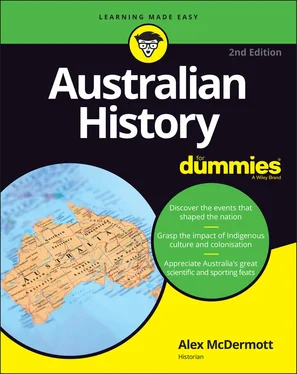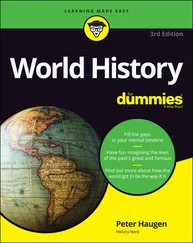FLINDERS GOES INVESTIGATING AND FINDS THE NAME AUSTRALIA
In 1803 the explorer Matthew Flinders circumnavigated the Australian continent in the Investigator . The only thing was the continent wasn’t called Australia. The western side of the continent had been named New Holland in the 17th century (which you can read more about in Chapter 2), while the eastern side of the continent was named New South Wales by Captain Cook after he’d sailed up along it in 1770 (refer to Chapter 3). Now that Flinders had gone around charting every nook and cranny of the continent, people could say for sure that no gulf or strait separated the two.
But what to call it? Flinders quite liked the Latin name that had been used in ancient Rome — Terra Australis , or ‘southern land’. But the Latin seemed a bit old fashioned. So he changed it to Australia. Not everyone liked it — Sir Joseph Banks (the botanist on Cook’s voyage and powerful patron of the settlement thereafter), for instance, thought it sounded terrible. So strongly did people not like it that when Flinders published his book in 1814 (just before he died), it was titled A Voyage to Terra Australis , rather than A Voyage to Australia . But in the intervening decade (between Flinders circumnavigating the continent and publishing his book) the name Australia had begun to stick with ordinary people living in the colony of NSW. Macquarie liked it, and in 1817 he formally requested that the name be used in dispatches and official correspondence. The Governor who came after Macquarie, Thomas Brisbane, liked the name so much that he called his daughter Eleanor Australia.
Macquarie’s Main Points of Attack
Macquarie wasn’t content with just occupying the colony — he wanted to push outward past and through previously impassable geographic barriers (like, say, the Blue Mountains; see the sidebar ‘Getting through the Blue Mountains blues’).
Macquarie also wanted to put Indigenous relations on a better footing. Macquarie figured that if he could act like an all-powerful chief with white colonists, he could act like a benevolent chief with the local Aboriginal people as well. The idea of having annual tribal gatherings, where he dispensed gifts and authority, and opening a school for Aboriginal children to be taught reading, writing and the various skills of European civilisation, appealed to him a great deal.
When it came to the convicts, while Macquarie was surprised and pleased at how successful convicts had become (refer to the preceding section), he also wanted them to behave in a more orderly, less raucous fashion. He did his best to make this a reality too.
Macquarie was keen to get the colony of NSW moving even faster, pushing the expansion of both settlement and the economy. Declaring new townships at the drop of hat, he was also big on road construction and public buildings. This was the Macquarie vision: To not simply cut costs and keep things quiet, but to build the place up.
Macquarie encouraged expansion of settlement by establishing new peripheral settlements in the colony, such as Windsor, Wilberforce and Liverpool. But the biggest challenge to expansion was the Blue Mountains, which essentially lay in a ring around the settlement. Various attempts had been made to penetrate the forbidding range since the first few months of the First Fleet’s arrival at Port Jackson, but so far none had been successful. The arable land available in the settlement was by now nearing exhaustion and Sydney was in danger of becoming a permanent ‘limpet port’ — a small-scale settlement that clung to the side of an unknown continent, depending solely on its maritime flow, ready for abandonment if and when the British Government decided to give up the project as a bad exercise. People didn’t even know what lay on the other side of the mountains. Desert? An inland sea? Or, as some convicts continued to believe, China?
 In June 1813, three settlers — Gregory Blaxland, William Lawson and William Wentworth — and their convict servants finally found a way over the Blue Mountains, discovering enough grassland on the other side to ‘feed all the stock in the colony for thirty years’. Macquarie sent his surveyor, George Evans, to investigate and Evans returned greatly impressed with what he had found: ‘I cannot speak too much of the country. The increase of stock for some 100 years cannot overrun it’.
In June 1813, three settlers — Gregory Blaxland, William Lawson and William Wentworth — and their convict servants finally found a way over the Blue Mountains, discovering enough grassland on the other side to ‘feed all the stock in the colony for thirty years’. Macquarie sent his surveyor, George Evans, to investigate and Evans returned greatly impressed with what he had found: ‘I cannot speak too much of the country. The increase of stock for some 100 years cannot overrun it’.
A new vista of what Australia might become opened up, and Macquarie set to work building a road out along the route through the mountains and proclaimed a new township — Bathurst.
GETTING THROUGH THE BLUE MOUNTAINS BLUES
For the first 25 years of white settlement, the Blue Mountains were a big problem. They formed a ring around the NSW settlements at Sydney, Parramatta and on the Hawkesbury River. If a way wasn’t found through the mountains, the colony would never reach its full potential.
The Blue Mountains weren’t like the regular ‘ordinary’ mountains the European settlers were used to. In order to cross European mountains, you found the valleys that went between the peaks and followed them. But this wouldn’t work with the Blue Mountains because their geological formation had been completely different. Rather than being peaks of land that had been thrust up by subterranean forces, the Blue Mountains formed part of a range that had originally been a plateau. Formed from sandstone rock, countless aeons had worn down most of the plateau, forming gorges and gaps between other parts that had retained their height. This meant that if you followed the valleys you wouldn’t go between the peaks, but would just find yourself running into walls and dead ends.
Between 1793 and 1804, numerous attempts were made to cross the Blue Mountains, with no success. The attempt in 1804 was made by George Cayley, a young protégé of Sir Joseph Banks (refer to Chapter 3for more on this rich botanist who had fingers in just about every Australian pie). Cayley reported back to the governor at the time, Governor King, that it was useless to try to cross such a ‘confused and barren assemblage of mountains’.
King agreed with Cayley. Moreover, he was worried about the rumours that kept inspiring convicts to run away: The distant view of the purple-blue mountains (which, of course, is how they got their name) was so inviting that convicts kept running away, believing that on the other side was a land where everything was perfectly lovely. King said this was stupid, and forbade people to try any further mountain crossings. And there, for the next ten years or so, is where the matter rested.
However, in 1813, Governor Macquarie, who liked the idea of pushing the settlement outward, hopefully discovering more fertile land and finding new outlets for the increasing population, encouraged a new attempt. Gregory Blaxland, a gentleman settler, William Wentworth, native-born youth, and Lieutenant Lawson set off from near Penrith. They tried a different strategy to the other explorers — rather than follow the valleys and try to hoist themselves over the ridges, they climbed up onto a ridge and kept following it. This way they got past and through the mountains, and happily reported on the fertile land on the other side.
The group hadn’t actually managed to get all the way through the bigger Great Dividing Range — that happened a year later with surveyor G W Evans — but they penetrated far enough to show how it could be done, and got a fair share of public acclaim for doing it. Finally, the colony could begin to properly expand into the Australian continent.
Читать дальше

 In June 1813, three settlers — Gregory Blaxland, William Lawson and William Wentworth — and their convict servants finally found a way over the Blue Mountains, discovering enough grassland on the other side to ‘feed all the stock in the colony for thirty years’. Macquarie sent his surveyor, George Evans, to investigate and Evans returned greatly impressed with what he had found: ‘I cannot speak too much of the country. The increase of stock for some 100 years cannot overrun it’.
In June 1813, three settlers — Gregory Blaxland, William Lawson and William Wentworth — and their convict servants finally found a way over the Blue Mountains, discovering enough grassland on the other side to ‘feed all the stock in the colony for thirty years’. Macquarie sent his surveyor, George Evans, to investigate and Evans returned greatly impressed with what he had found: ‘I cannot speak too much of the country. The increase of stock for some 100 years cannot overrun it’.










